Menu
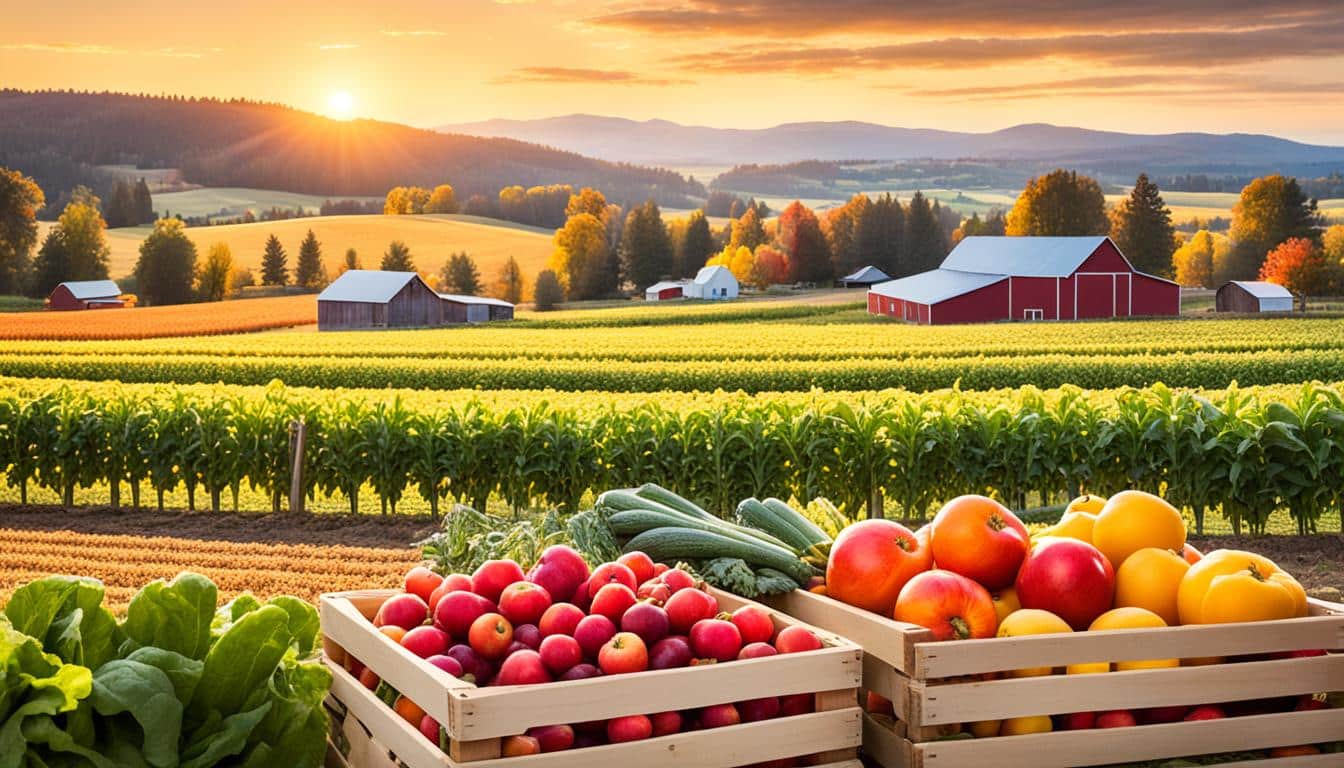
Did you know that in Texas, the latest time to plant tomatoes is around July 1? You can harvest these tomatoes until September or October. The warm days of summer give way to cooler autumn weather. This signals a change in how we garden. This autumn harvest guide helps gardeners get a good crop in the fall. It talks about preparing the soil right, picking crops that like the cold, and protecting plants from frost.
Getting the soil ready and knowing when to mulch, keep pests away, and when to plant is key. This guide will help you plant in a way that your crops do well in autumn. Think about the first frost and pick plants like greens, roots, and brassicas. Using succession planting helps keep your garden producing for longer.
To beat the frost, you can use coverings or special plant types that can survive it. Checking your plants regularly and gardening the natural way are very important as autumn comes. We want to help those who care about the earth grow food successfully in autumn.
Autumn brings unique gardening techniques and chances. Cooler weather lets you enjoy fall harvesting of various Autumn crops. It’s a key time to start autumn tasks for a successful harvest season. I’ll share important Autumn gardening tips to boost your garden this season.
Start by keeping the soil healthy for strong crop growth. Nourished soil with the right pH level boosts your yield. Smart crop rotation means switching to cool-weather plants after the summer’s warmth leaves. This not only saves space but also uses soil nutrients better.
With less light and temperatures changing, you need to adapt your gardening techniques. Watch out for frost and be prepared to protect your plants. Simple covers made from old sheets or cardboard can help against frost. Remember, well-watered plants can handle frost better.
Succession planting is great for extending your harvest season. By planting new crops as you pick the old, you keep getting harvests. Knowing the best time to plant each crop is key for a good yield. It also makes the most of your garden’s space and time.
Autumn is a time to learn from global Fall Harvest celebrations. These festivals, like Thanksgiving in the United States and Canada, mark the harvest’s bounty. The Chinese Mid-Autumn Festival also holds cultural importance and is celebrated widely in Asia. By sharing these traditions in schools, we encourage respect for others’ cultures. This helps build community spirit and values of appreciation for the different ways we celebrate the harvest.
Follow these Autumn gardening tips to get ready for a season of plentiful harvests. They will help you make the most of autumn’s offerings in your garden.
Getting your soil ready is key to a great autumn garden. Transitioning from summer to autumn means focusing on soil health. This makes sure you get a good harvest. To do this, test your soil, add fertilisers, and mix in organic matter.

It’s crucial to know your soil’s condition. Test it every 3 to 5 years to find out what nutrients and pH it has. Most veggies do best in soil with a pH of 6.0 to 7.0. After getting your results, you can add nutrients like nitrogen or potassium if needed.
Adding organic matter is really important. Mixing in compost or manure boosts soil fertility slowly. This helps plants grow strong and supports the soil’s ecosystem. It also fits well with caring for the environment.
In late autumn, cover your garden with compost or fallen leaves. This feeds the soil, stops winter weeds, and prevents erosion. Planting crops like clover in winter adds nutrients and more organic matter to the soil.
Good soil structure is a must for healthy plants. Adding a 2-4 inch layer of compost helps a lot. It makes the soil richer and easier for plants to get water and grow roots. Cover crops like field beans also keep soil in good shape and add more organic matter.
Experienced gardeners use tricks like crop rotation. This prevents soil from getting tired and lowers the chance of diseases. It keeps the soil balanced and the plants healthy.
| Technique | Benefits |
|---|---|
| Soil Testing | Ascertain nutrient levels, adjust pH |
| Organic Compost | Gradual nutrient release, improve soil structure |
| Cover Crops | Add nutrients, protect soil from erosion |
| Manure Application | Feed the soil, suppress weeds |
| Crop Rotation | Prevent soil depletion, reduce disease risk |
Picking the right crops for autumn is crucial for a good harvest. Look to cool-season vegetables for the best results when the weather gets colder. They can be a great addition to your garden.
Cool-season veggies love the lower temps, making them perfect for planting in autumn. Plants like broccoli and cauliflower are ready in 50-80 days and can handle a light frost. Brussels sprouts are the toughest, taking 90-100 days to mature and surviving temperatures as low as 20°F. They often taste even better in the cold.
Autumn is also great for growing root vegetables. Beets are reliable, taking 50-60 days to grow and coping with the high 20s. Radishes are quick, ready in just 30 days, but they need to be picked before the ground freezes. Turnips last about 50-60 days to grow and can manage a light frost, making them a good choice for autumn gardens.
Leafy greens and brassicas do well in the autumn, offering fresh crops as it gets colder. Spinach grows fast, in 35-45 days, and can handle light frost, sometimes surviving winter. Kale lasts 40-65 days to grow and is tough at 20°F, ensuring a good supply. Swiss chard is another option, ready in 40-60 days and also tough in light frost, giving you soft, tasty leaves. Brussels sprouts, broccoli, and cabbage are part of the brassica family, noted for their strength and nutrition.
Here’s a list including cool-season, root vegetables, and leafy greens. It shows how long they take to grow and what temperatures they can survive:
| Vegetable | Maturity Period (Days) | Frost Tolerance (°F) |
|---|---|---|
| Beets | 50-60 | High 20s |
| Broccoli | 50-70 | Light Frost |
| Brussels Sprouts | 90-100 | Down to 20°F |
| Cabbage | 50-90 | Down to 20°F |
| Cauliflower | 60-80 | Light Frost |
| Collard Greens | 40-65 | Down to 20°F |
| Green Onions | 60-70 | High 20s |
| Kale | 40-65 | Down to 20°F |
| Spinach | 35-45 | Light Frost |
| Swiss Chard | 40-60 | Light Frost |
| Turnips | 50-60 | Light Frost |
By choosing these tough seasonal plants, you can ensure a great autumn garden. Planning well means you’ll have plenty of cool-season vegetables, root veggies, greens, and brassicas to enjoy.
Knowing your local frost dates is key for a good autumn planting plan. These dates show when the first or last freeze might happen. They’re important for knowing when to plant for the best harvest. Tools like the Frost Date Calculator can help with specific areas.
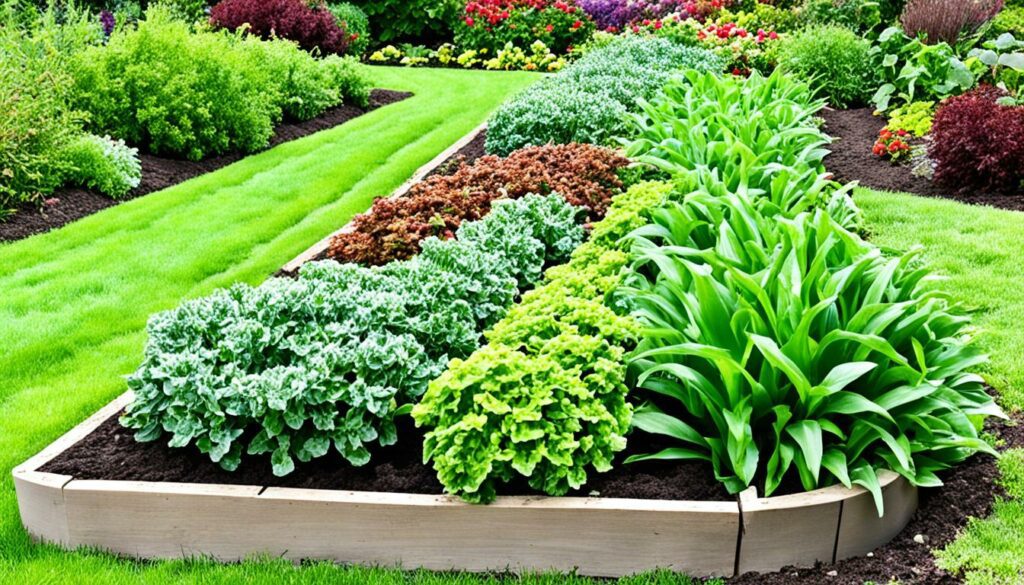
To figure out first frost dates, know when it usually hits 32°F in your region. The Old Farmer’s Almanac and National Gardening Association offer this info by zip code. Remember, these are averages and can change yearly. But, using this info can make your planting times better.
Timing your plants right is vital for a great autumn harvest. Plant cool-season veggies in early spring when the ground is warming up. Wait for warm soil to put in summer crops like tomatoes. Add in some late-season options to extend your harvest. Think about planting different crops at different times for a steady supply.
Plant hardiness zones are helpful for autumn planting. They tell you about your area’s frost dates and how many days are thawed. Use this info to choose crops that match your climate. For instance, Zone 5 is good for autumn crops because it has 180 frost-free days.
By using frost dates and hardiness zones, you can boost your autumn planting success. It’s all about timing your crops right for the best yield.
In Alabama, autumn gardening requires knowing how to plant well. We will look at planting seeds directly or using transplants. Also, we’ll discuss the best ways to space your plants, the importance of putting down mulch, and how to control weeds. All these steps help you get the most out of your garden in the fall.
Deciding whether to plant seeds directly or use transplants matters. Seeds are best for carrots and radishes because these veggies don’t like being moved. However, transplants work better for kale and broccoli. This is because the summer heat in Alabama can be over 85 degrees F. Such heat makes it hard for seeds to grow into plants, especially cool-season crops like lettuce and spinach. Knowing which method to use can make your garden thrive.
To have healthy plants, they need enough space and to be planted at the right depth. Every plant should have plenty of space to grow. North Alabama and South Alabama will have different planting times because of climate. Giving your plants about 1 inch of water every week is important. This helps them stay hydrated and avoid too much competition for water.
Mulching in autumn helps keep the soil moist and stops weeds. This is important since the fall season can be unpredictable with temperature and rainfall. Mulch keeps the ground damp, which is good for dry periods in Alabama’s transition from summer to fall. Also, using mulch stops weeds from taking over, helping your plants get the nutrients and space they need to grow strong.
| Technique | Best For | Considerations |
|---|---|---|
| Direct Seeding | Root Vegetables | Not ideal for hot climates (>85°F) |
| Transplants | Leafy Vegetables | Beneficial for slow-growing crops |
Autumn means it’s time to change how we water our gardens. Most plants need 1 to 2 inches of water each week. You should spread this water over 1 to 3 times a week. Adjusting the amount and when you water, based on the soil and plant type, helps the plants deal with drought better and gives you more produce.
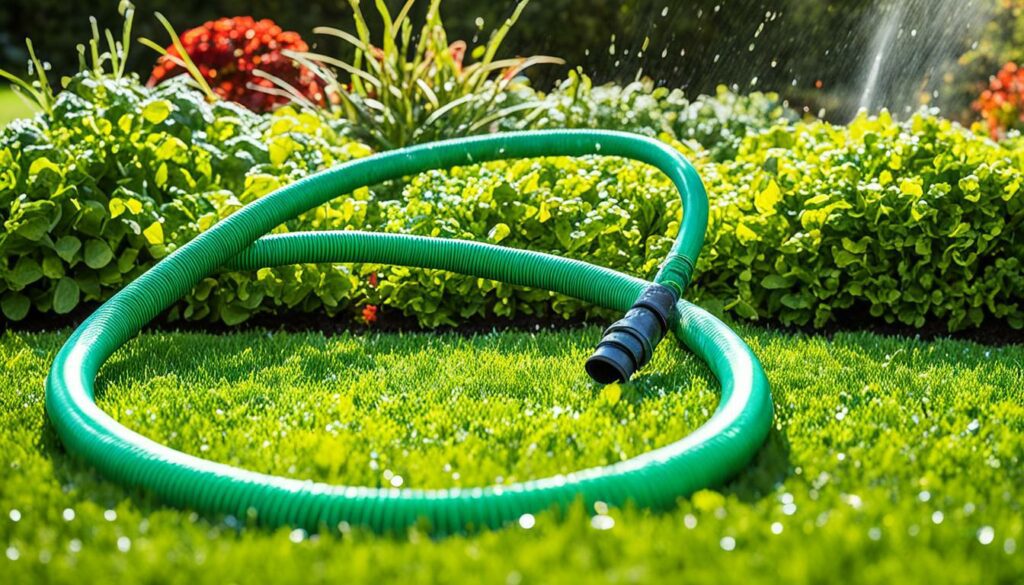
It’s important to know what kind of soil you have for the best watering plan. Sandy soil needs more water but less often. Clay soil should be watered slowly to prevent water from running off. If you have silty soil, water lightly but often. Loamy soil is the easiest for plants, as it drains well and holds moisture just right.
Different vegetables need different amounts of water, depending on how deep their roots go. Plants with shallow roots need more water but more often. Tomatoes, asparagus, and watermelons, with deeper roots, should get a lot of water less often. Water needs can also change as plants grow. New seeds need constant moisture, but once plants are established, they might need less.
It’s key to spot signs of too little or too much water. Finding the right balance early helps your plants grow well.
Weather can be unpredictable, so you must watch closely. In very hot weather, plants might need water every day to stay healthy. As it cools down, you can water less frequently. Before the first frost, plants might need a little extra water to prepare for winter.
Plants in pots dry out faster and need more attention. It’s best to water them in the morning or evening. Adding compost to your soil can help with drainage and stop waterlogged roots.
By understanding these watering tips, gardening in the fall can be very rewarding. It helps your plants grow strong, even as the weather gets colder.
In autumn, the risk of frost grows. Missoula sees its first frost around September 22nd. For gardeners, this means being watchful and using various methods to keep their plants safe.
Frost cloths are great for keeping plants warm during light freezes of 29°F to 32°F. They make a cosy space around the crops, shielding them from night chills. In Missoula, these cloths can stretch your growing season well past mid-October.
Want to go hands-on? Try crafting protective barriers from stuff like old blankets or bubble wrap. These household items can act as a shield against frost, protecting your plants. For extra cold nights, adding a straw or leaf mold mulch can give even more warmth to your plants.
Choosing the right crops can also help. Some veggies like broccoli and spinach can take the cold, down to 28°F. Others, like beet and lettuce, survive slightly higher temps of 28°F to 32°F. Planting these can help you get a good harvest despite frosty weather.
| Vegetables | Frost Tolerance Temperature |
|---|---|
| Broccoli | 29-30°F |
| Kale | 27-29°F |
| Spinach | Below 28°F |
| Beet | 28-32°F |
| Lettuce | 28-32°F |
Being proactive with these tips can help you sail through autumn, protecting your crops and getting a great harvest.
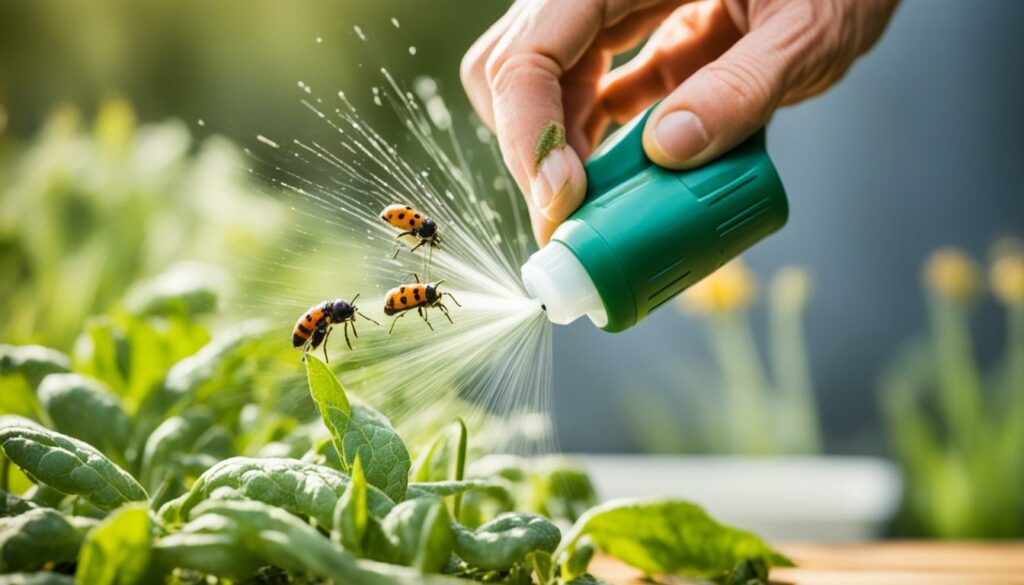
Fall brings a lot of garden pests, making it important to stay alert. Keeping these pests in check saves your crops. I’ll talk about spotting common fall pests, using natural pest control, and preventing infestations to keep your garden healthy in autumn.
Spotting fall pests early is crucial. For instance, Aphids are troublesome as they have live babies who can have babies in just over a week. This fast life cycle makes them a common issue. Cabbage loopers and Colorado potato beetles can also be a big problem, as they multiply quickly.
Corn earworms and tomato fruitworms add to the threat during the summer, with new bugs appearing every few weeks. Then, in the autumn, the scene is taken over by cucumber beetles, cutworms, and stink bugs, making it even tougher.
Here’s a quick look at common fall pests and how they reproduce:
| Pest | Reproductive Behaviour |
|---|---|
| Aphids | Reproduce within seven to ten days |
| Cabbage Loopers | Several generations per season, peak in fall |
| Colorado Potato Beetles | Up to 350 eggs, multiple generations |
| Corn Earworms & Tomato Fruitworms | New generations every 28-35 days |
| Cucumber Beetles | Several generations, both larval and adult damage |
| Cutworms | Up to three generations in northern climates |
| Stink Bugs | Several generations troubling late-season crops |
Organic pest control keeps the environment safe and helps other useful animals like birds and butterflies. An approach called Integrated Pest Management (IPM) uses a mix of tactics. This includes adding helpful bugs like ladybugs to eat aphids or using Bacillus thuringiensis to tackle caterpillars safely.
Keeping the soil healthy with compost makes plants strong, less likely to be eaten by pests. This boosts the garden’s natural defences.
Preventing pests is key to a happy garden. Start by rotating crops and choosing plants that suit your garden best. It’s also important to create spaces for good bugs and keep everything clean. This reduces the places pests like to hide and breed.
Checking your plants often helps you catch and stop problems early. This way, your fall season will be full of healthy, pest-free plants.
Getting harvesting right boosts the quantity and quality of your autumn fruits and vegetables. It’s important to know when each crop is at its best to pick, with various tactics to help. This guide will show you how to get the most from your harvest.
Picking at the right time means food is fresh and tastes the best. For things like lettuces, aim for early mornings when they’re crisp. Carrots and beets, though, get sweeter after a frost. Picking at the right time affects flavour and how long the food stays good.
Different crops need different care to thrive:
After picking, it’s vital to handle your crops right to keep them fresh. Store them how they like to stay at their best. Here’s what works:
| Dry Matter Percentage | Ideal Storage Duration | Field Drying Time |
|---|---|---|
| 35% | Short-term (1-2 weeks) | 1 to 2 days |
| 55% | Medium-term (2-4 weeks) | 2 to 4 days |
| 85% | Long-term (4-6 weeks) | 4 to 6 days |
Touch crops gently and keep them in the right conditions. This stops them going bad too soon and keeps their goodness. Leafy greens prefer it cold and wet, while roots like cool and dark.
By understanding harvest timing and how to handle your crops after, you keep your autumn food fresh and full of goodness. This is important for everyone growing, from small gardens to big projects like the North County Community Food Bank. They help many people by providing fresh food every month.
As the growing season ends, how we store our crops becomes vital. Storing well lets us enjoy our harvest into winter. With the right methods, gardeners can keep their fruits and vegetables fresh.
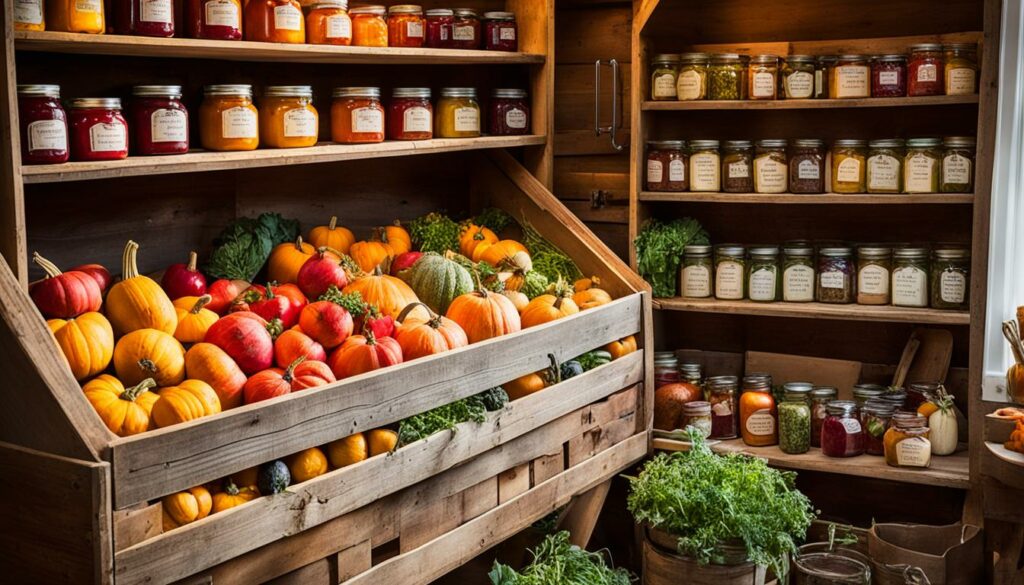
Keeping things fresh for immediate use is key. Potatoes and onions, harvested in September, need a cool, dark spot. This stops them from sprouting. Garlic, also ready then, likes a well-ventilated place to last longer.
But courgettes should be eaten soon as they don’t keep well. In the fridge’s crisper, veggies stay moist and tasty.
To keep food for a long time, consider canning, freezing, or drying. Tomatoes, picked through October, are great for chutneys. They add flavour when summer’s over. Squashes, like butternut, should sit in the sun for a week. This step makes them last months.
Freezing after blanching keeps veggies at their best. Pressing out air from freezer bags or containers helps them stay fresh.
To keep food fresh, know how each type needs to be stored. Apples need a dark, cold space, like a garage. Good packaging can cut spoilage. For carrots, store them in the fridge without their green tops. This keeps them from drying out.
By storing well, you not only save money but also help the planet. This is because you throw away less food.
Use both short and long-term storage methods wisely. This way, enjoy your autumn bounty and waste less. Plus, everything stays fresh.
Succession planting is a great way to keep your garden full. It helps in having crops all through autumn. By carefully choosing what plants to grow together, you can see continued growth. Planning helps make your garden space work better.
Thinking ahead is key to keep getting fresh crops. It’s all about knowing when to plant, so there’s always something ready to pick. For instance, you can plant radishes every 2-3 weeks since they grow fast. Or, set lettuce seeds every 3 weeks to keep salad bowls full.
The right choice of plants is critical for this method to work. Here’s a handy chart outlining when to plant various vegetables for continuous harvests.
| Crop | Time to Maturity | Recommended Sowing Interval | Last Recommended Sow Date |
|---|---|---|---|
| Lettuce | 4-8 weeks | 3 weeks | 4 weeks before first frost |
| Cucumbers | 50-70 days | 3-4 weeks | 4-6 weeks before first frost |
| Carrots | 55-80 days | 21-30 days | 3 months before last frost |
| Tomatoes | 50-85 days | 4 weeks | 60-80 days before first frost |
| Radishes | 3-5 weeks | 2-3 weeks | 4-6 weeks before first frost |
To grow many crops at once, you must use your space well. Make sure you understand how much space plants need. Fast-growing crops, like radishes, can fill the gaps between slow growers. This makes the most of your space. Also, rotating plants weekly helps keep productivity up and avoids using too many resources.
Autumn is a great time for organic gardening. It brings many rewards and helps the planet. By using these methods, we support sustainable farming and create a healthier garden.
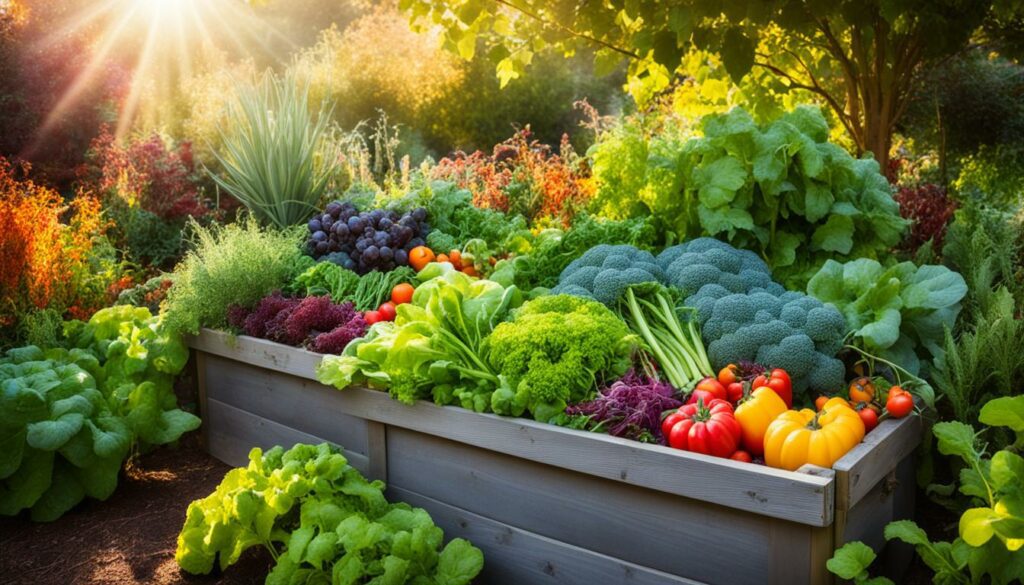
Going organic means we don’t rely on harmful chemicals. This supports both the soil’s health and the variety of life in our gardens. Plus, gardening in the fall is easier than in the summer. This is because most pests are gone, making it simpler to grow crops like squash.
Using natural fertilisers and organic pesticides is key to a strong garden. Making compost helps recycle waste into food for plants. This is cheap and boosts the soil. Also, natural fertilisers feed plants slowly, helping them grow well. Organic pesticides keep pests under control without hurting the good bugs or larger environment.
Good soil is vital for a great organic garden. We can make soil better by adding compost and mulch. This improves how soil keeps water, which is crucial in autumn. Cover crops and rotating plants also help keep soil healthy. They are important steps towards sustainable farming.
| Practice | Benefits |
|---|---|
| Natural Fertilisers | Enhances soil fertility and provides slow-release nutrients |
| Organic Pesticides | Reduces pest pressure without harming beneficial insects |
| Composting | Creates nutrient-rich soil amendments from garden waste |
| Crop Rotation | Prevents soil depletion and reduces disease incidence |
Practising these organic methods makes our fall gardening truly rewarding. Our gardens become both fruitful and kind to the environment. This full approach ensures our gardens thrive, supporting us for years to come.
Using sustainable farming methods is key in today’s agriculture. It marries efficiency with caring for our planet. At Small Valley Farm, we focus on crop rotation.
We plant different crops in the same spot every other year. This keeps the soil healthy and rich. It fits perfectly with AG’s aim for agricultural sustainability.
Small Valley Farm shows this by rotating a mix of crops over its 120 acres every year. They grow tofu soybean, corn, and other plants. This mix ensures the crops get the nitrogen they need. It also prevents the soil from becoming tired over time.
Factors like fall rains in Oklahoma are vital. They help moisten the soil, boosting vegetable growth. Environment-friendly farming uses techniques like cold frames in the winter. These methods keep crops thriving all year. They are especially good for eco-friendly gardening fans wanting a longer harvest season.
It’s important to look at how varied your crops are. If the time between planting the same crops again is too short, it can hurt the soil. Keeping a good mix and giving the soil time to rest is crucial.
Using water efficiently is also a big part of being sustainable. Drip irrigation is one method that works well. It gives plants the right amount of water. This boosts their growth and saves water. Managing pests in the fall is also critical. Quick action helps protect the crops.
Consider these surprising facts:
| Aspect | Sustainable Farming |
|---|---|
| Energy Consumption | Up to 56% less per plant unit |
| Greenhouse Gas Emissions | 64% fewer per hectare |
| Job Creation | 30% more jobs possible |
| Biodiversity Support | Higher biodiversity than conventional farming |
Sustainable farming does cost more in time and money. But, the demand for eco-friendly products is growing. This can lower costs. It makes sustainable goods more affordable for everyone.
The main aim of sustainable farming is to help now and in the future. It must be profitable, good for the environment, and fair to people. By following these steps, farming can stay strong and help the planet.
Keeping a good eye on your garden can make a big difference in your harvest. You need to check the soil and watch how much water you give your plants. Also, spreading mulch will help your garden grow right without many issues.
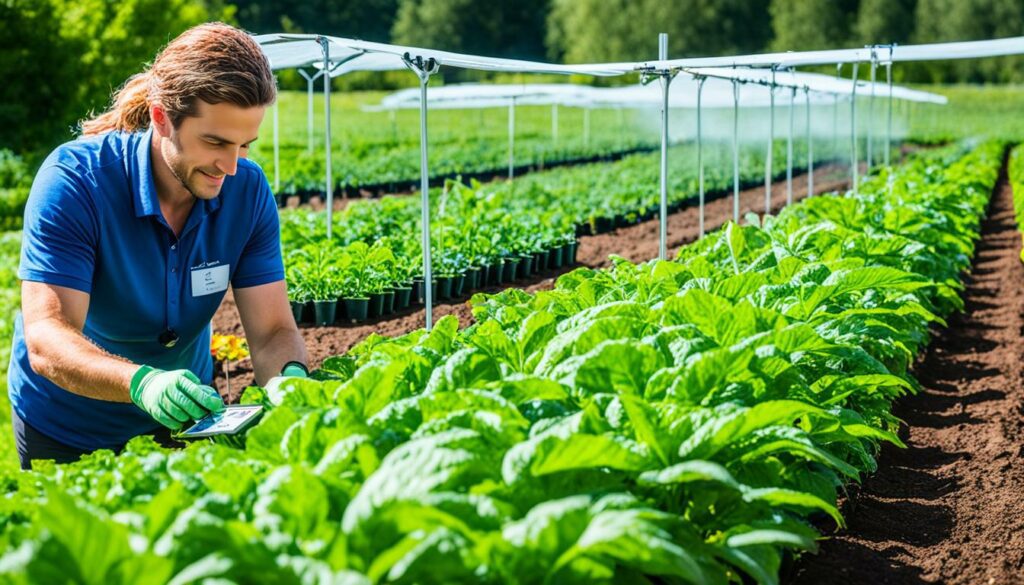
Checking your garden often is key. This helps spot if your plants need something or if there are bugs around. You’ll get better crops by keeping an eye on things and making small changes as needed.
The weather can change quickly, which affects your garden. You can protect your plants from sudden frost with special covers or barriers. Knowing when the first frost is can also help you plan better.
Writing in a garden journal is really helpful. You can keep track of what works and what doesn’t each season. This way, you learn over time how to make your garden more successful.
| Aspect | Adapting Strategy |
|---|---|
| Soil Preparation | Testing and amending with organic matter |
| Watering Schedules | Adjusting to match seasonal changes |
| Frost Protection | Using frost cloths and mulching |
| Pest Management | Regular inspections and organic control methods |
| Garden Documentation | Maintaining a detailed journal |
The autumn harvest is coming to a close. Now is a good time to look back on our garden’s journey. From preparing the soil to harvesting, it’s been full of hard work and lessons. Looking at what went well and what we can do better helps us improve for next year.
With the season ending, we celebrate our harvest. Our leafy greens thrived and root vegetables grew as they should. This success comes from following the best farming methods. Onions and garlic, grown at the right time, will remind us of our efforts next summer.
But, the end of the season is not just for rejoicing. It’s also a time for important tasks that help future success, like caring for the soil and rotating crops. This ensures the effects of our work last into the next year. As we prepare for winter, we also get ready for more learning and improvement in the garden. The cycle of gardening continues, and each harvest helps us grow and find joy in what we do.
Cool-season crops like spinach, kale, and broccoli do well in autumn. Also, consider beets, carrots, and radishes. They taste sweeter in the cooler weather.
First, test your soil to see its pH and nutrient levels. Add compost and organic fertilisers. This improves the soil’s quality for plants.
Use frost cloths or old sheets to cover your plants. Frost-resistant plants are a good choice. They add extra protection against frost.
Focus on deep watering to help plants grow strong roots. Be careful not to overwater. It can cause plants to get sick.
Check your garden often for pests like aphids. Use natural methods to get rid of them, like introducing helpful bugs. Keeping your garden clean helps too.
It’s best to plant depending on your area’s frost dates. Check a plant hardiness zone map. This will help you know when to plant.
Organic gardening helps keep the soil and the plants healthier. It avoids harmful chemicals. Use natural fertilisers, compost, and good crop rotation to grow strong plants.
Keep your produce cool and dry for short-term use. For the long term, you can freeze, dry, or can it. This keeps the food good for longer.
Succession planting means you plant crops at different times. This keeps fresh produce coming all autumn. It makes good use of your garden space and resources.
Good soil structure helps plants get the water and air they need. Adding compost improves soil quality. Plants grow better in well-structured soil.
Use a garden journal to keep track of what you do and what happens. This helps you learn for next year. It makes your garden more productive.